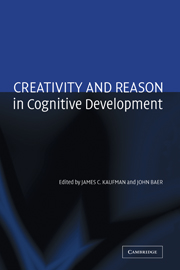Book contents
- Frontmatter
- Contents
- List of Contributors
- Acknowledgments
- Creativity and Reason in Cognitive Development
- Introduction
- COGNITIVE PERSPECTIVES
- DEVELOPMENTAL AND EDUCATIONAL PERSPECTIVES
- 12 Creativity in Young Children's Thought
- 13 A Young Artist's Story: Advancing Knowledge and the Development of Artistic Talent and Creativity in Children
- 14 Is It Reasonable to Be Creative?
- 15 Does Culture Always Matter: For Creativity, Yes, for Deductive Reasoning, No!
- 16 Higher Level Thinking in Gifted Education
- 17 The Relationship Among Schooling, Learning, and Creativity: “All Roads Lead to Creativity” or “You Can't Get There from Here”?
- 18 How Early School Experiences Impact Creativity: An Ecological Perspective
- 19 Conclusions
- Author Index
- Subject Index
- References
19 - Conclusions
Published online by Cambridge University Press: 19 January 2010
- Frontmatter
- Contents
- List of Contributors
- Acknowledgments
- Creativity and Reason in Cognitive Development
- Introduction
- COGNITIVE PERSPECTIVES
- DEVELOPMENTAL AND EDUCATIONAL PERSPECTIVES
- 12 Creativity in Young Children's Thought
- 13 A Young Artist's Story: Advancing Knowledge and the Development of Artistic Talent and Creativity in Children
- 14 Is It Reasonable to Be Creative?
- 15 Does Culture Always Matter: For Creativity, Yes, for Deductive Reasoning, No!
- 16 Higher Level Thinking in Gifted Education
- 17 The Relationship Among Schooling, Learning, and Creativity: “All Roads Lead to Creativity” or “You Can't Get There from Here”?
- 18 How Early School Experiences Impact Creativity: An Ecological Perspective
- 19 Conclusions
- Author Index
- Subject Index
- References
Summary
Having come this far, do we now have a clear answer to the question of how the development of reasoning skills and the acquisition of knowledge influence the development of creativity (and, conversely, how the development of creativity affects reasoning skills and knowledge acquisition)? We hope no reader has been expecting a simple yes or no answer or even a formula expressible in a simple, linear equation. Nothing about creativity, reasoning skills, or knowledge acquisition is ever that simple, and developmental relationships of all kinds tend to be complex. The relationship among the development of creativity, reason, and knowledge is no exception.
That said, it seems fair to say at least that creativity and reason only rarely and in rather special circumstances need to be in direct opposition to one another, and they often are (or at least can be) complementary. The opposition that one sometimes finds in educational settings between the development of creativity on one hand and the improvement in reasoning skills and content knowledge on the other, such as described by Beghetto and Plucker and by Paris et al., although admittedly common, is (as both chapters point out) often simply an unnecessary result of the kinds of learning experiences and classroom structures students sometimes encounter. Many of the more blatant kinds of conflicts that arise could be avoided by more constructivist teaching techniques. Conflict can often be transformed into synergy.
- Type
- Chapter
- Information
- Creativity and Reason in Cognitive Development , pp. 351 - 356Publisher: Cambridge University PressPrint publication year: 2006
References
- 3
- Cited by



